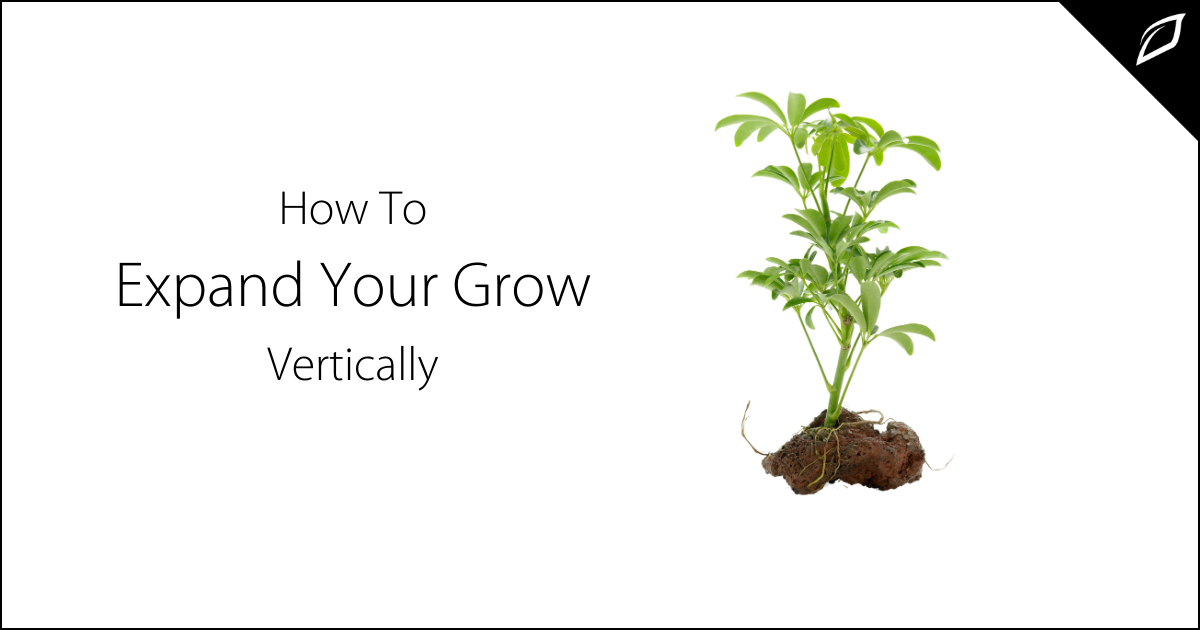B Force Farm Highlight
Recently, our very own Account Executive Jim Stephens went on-site in the great pacific northwest to visit one of our favorite customers, B Force...


A lack of space to expand crop size has been a limiting factor for growers and farmers for as long as agriculture has existed. Still, thankfully, technology has answered the call for help with an increasingly popular solution – grow up.
While extra floor space is often hard to come by, vertical space is usually readily available. It could be argued that the vertical space in most indoor grow operations is outright wasted. By finding new ways to use that wasted space, growers can supersize their yields without ever having to expand a single square inch on the ground.
Growers looking to expand vertically have some decisions to make as to how they want to do it. The first and most common method is stacked growing – taking the same equipment and layout as horizontal growing and adding new layers stacked one on top of the other in the vertical. The second option is growing in the vertical plane – using towered infrastructure to grow plants one on top of another instead of in side-by-side rows.
There are benefits and drawbacks to both, but simplicity and cost are two of the significant factors. A grower looking to expand their operation by stacking has a lot of options available to them. Hanging potters, wall mounted shelving, mobile growing platforms, or even just multi-level rolling racks from Walmart are all completely viable ways to start expanding upwards. The downside is that stacking also requires all of the other infrastructures – like lighting and irrigation – to be figured out for each additional level.
Growing in the vertical plane requires more customized infrastructure, but it also provides some significant benefits over stacking, including better natural airflow and less sophisticated lighting and irrigation. The tradeoff is that there are far fewer off-the-shelf options for growing in the vertical plane than there are for stacked horizontal growing, making this technique far more appropriate for large-scale industrial growers than smaller commercial or hobby operations.
The associated difficulties can generally be addressed relatively quickly through careful planning and the right equipment.
Ergonomics:
One easy to overlook challenge is that as infrastructure gets taller and taller, the grow environment becomes less and less ergonomic for the humans involved in the growing process. That’s not necessarily a huge deal for small hobby growers that might only be going a couple of levels high. Still, for more extensive operations, it can have a significant impact on labor – including costs.
The solution to this problem could be as simple as a step-ladder, depending on the heights involved. Still, for some industrial growers, crops become stacked so high that scissor lifts become necessary for employees to access the higher levels. Scissor lifts are extremely dangerous without proper training, so grow operations looking to employ them absolutely must ensure their employees are properly certified.
Air, Water, and Light:
Stacking vertically introduces some complications with providing plants with the resources they need to grow. Plants are selfish, and they generally don’t respond well to overcrowding, which is a real risk in vertical growing. Overcrowded plants suffer from a lack of airflow and needless competition for water and light, and the result is that while crop yields might go up, the quality will almost certainly go down.
The solution is to plan spacing and resource delivery carefully. Stacking requires that plants be given enough space both vertically and horizontally to allow proper airflow. It also requires fans to be employed to continuously move lousy air out and distribute fresh, clean air in its place. Irrigation and lighting need to be planned to ensure that the ones above it starve no single level. That can be done by providing that each level is individually plumbed and lit, which is simple enough but does mean extra costs.
From a lighting perspective, growers looking to maximize the use of vertical space can gain a lot by switching over to LED lighting. Because LED lights give off a fraction of the heat of fluorescents or incandescent, far less space is required between bulb and plant. That means growers can pack more levels in from floor to ceiling without having to worry about burning or heat damage as their plants grow taller.
Control:
More plants mean more work and more potential for human error. There is no point in expanding a crop if the new plants are going to suffer due to lack of attention, lack of labor, or lack of ability to handle the expansion. Unfortunately, it isn’t uncommon for indoor farms to fail for exactly that reason.
The solution is to implement automated controls as much as possible, reducing or eliminating the potential for human error and maximizing the chances of large, healthy yields. Advances in crop sensors, control units, and automated systems have shifted agriculture from an art to a science, and it’s now possible for growers to automatically monitor and control their operations with such accuracy that it’s possible to ensure each plant is getting the exact amount of water, light, nutrients, and air that it requires.
Vertical growing offers a highly promising solution to limited ground space, and it’s rapidly gaining in popularity as a result. The future may very well be one in which the majority of crops are grown vertically indoors, but for now, expanding into otherwise wasted vertical space is a great way for growers both big and small to significantly boost their yields without having to develop their physical footprint.

Recently, our very own Account Executive Jim Stephens went on-site in the great pacific northwest to visit one of our favorite customers, B Force...

Too much of anything can be a problem. Light is no exception, and a thoughtful grower needs to be strategic about the placement and strength of light...

Agtech has had a profound impact on the agricultural landscape. As a blanket term, "agtech" has been used to describe a host of innovations...